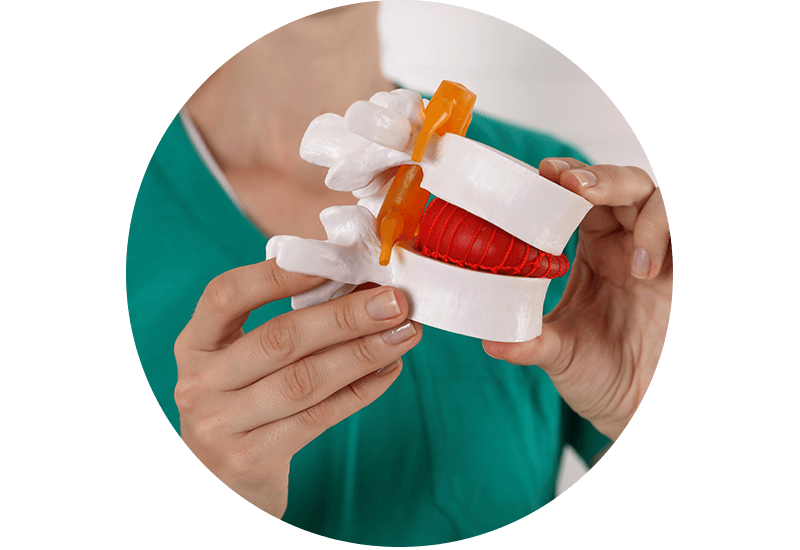Lumbar Decompression

Lumbar decompression surgery is performed using minimally invasive techniques. This procedure is performed to relieve the symptoms and pain associated with nerve compression. The main spinal condition corrected by lumbar decompression surgery is spinal stenosis. Only part of the lamina and part of the overgrown facet joints are removed to conserve bony structures needed for stability of the spine. Removing the thickened ligament (ligamentum flavum) is also performed to achieve complete decompression.
The minimally invasive technique utilizes one small incision to allow the surgeon access to the affected area, and the soft tissue and muscles are gently dilated with a tubular system. This advanced procedure can be executed in less time and with less damage to the surrounding tissue, and with less pain to the patient, than the traditional open method of surgery.
How the surgery works
This procedure requires the patient to be under general anesthetic so the patient will be unconscious for the duration of it and will not feel any pain as the surgery is performed. The patient will be placed prone (face down) on a special operating table that allows the surgeon easy access to your spine. After cleaning and sterilizing the surgical area, a small incision about 1.5 centimetres will be made at the affected spinal level. An X-ray is used to confirm the proper location is being operated on. Your surgeon will then insert soft tissue dilators to separate the muscle fibres. A tubular retractor is inserted over the dilators which are then removed. Special instruments are used to remove a portion of the lamina (the bone that comprises the back of the spinal canal) to expose the spine. Soft tissue (ligamentum flavum) and a portion of the overgrown facets are removed. This will allow the nerves to have adequate space in the spinal canal. Your surgeon will also investigate for any bone spurs that may be causing your spinal compression and will remove any that are found.
Once your lumbar decompression surgery has been completed, your surgeon will carefully reapproximate the muscle and tissue that had been divided back into place and strong sutures will be used to stabilize them. The incision is closed with dissolvable sutures and surgical tape (Steri-strips) will be placed. The incision will be covered with a small dressing.
Minimally invasive lumbar decompression surgery usually takes around 1 hour to complete.
Postoperative care
Minimally invasive lumbar decompression is performed as a day surgery, and you will be discharged from the surgical centre shortly after you have recovered from the effects of general anesthetic. Because there will have been less cutting or trauma to the muscles and tissues surrounding the affected spinal level than in traditional surgery, your level of pain in the surgical area following the procedure should be minimal. You will be given a set of postoperative instructions. You will also be advised to avoid twisting your back or bending over for at least the first week or two after surgery.
Frequently Asked Questions
Because the recovery time for our minimally invasive lumbar decompression surgeries is reduced when compared to the traditional open method of surgery, you should be able to return to work in a reduced capacity a week or two following your procedure. Depending on how quickly your pain subsides and the muscles regain their strength, most patients are able to return to full work and recreational activities around 4 to 6 weeks after their surgery.
Studies have shown that lumbar decompression surgery can be very successful in improving physical function and reducing the symptoms associated with spinal stenosis. One such study states that 80-90 per cent of people who receive this treatment are relieved of nerve-root pressure pain.
This type of minimally invasive spinal surgery requires very little wound care. You will leave the surgical centre with a small dressing and this should be left on for three days. After three days, the wound can be uncovered and exposed to air. The surgical tape keeping the suture in place should not be touched and the area where the incision has been made should be kept dry and clean. When taking a shower, the wound should be covered by a bandage and care should be given to ensure you do not get water directly on it. Bathing is not recommended until roughly five days after the procedure.
Receive the care you need right away
Horizon Surgical can expedite your minimally invasive spine surgery to be done in a timely fashion. From beginning to end, you can typically receive your minimally invasive spine surgery within a couple months. With our reduced recovery times, you’ll be able to get back to living your life and doing what you love most right away.
Call Us
Contact Us
- Phone: 403-619-2288
- Fax: 403-685-8137
Hours
- Hours of Operation:
Monday: 9:00am-4:00pm Tuesday: 9:00am-4:00pm Wednesday : 9:00am-4:00pm Thursday: 9:00am-4:00pm Friday - Sunday: Closed
